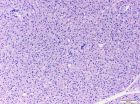(Press-News.org) PHILADELPHIA - Brown fat is a hot topic, pardon the pun. Brown fats cells, as opposed to white fat cells, make heat for the body, and are thought to have evolved to help mammals cope with the cold. But, their role in generating warmth might also be applied to coping with obesity and diabetes.
The lab of Patrick Seale, PhD, at the Perelman School of Medicine, University of Pennsylvania, studies what proteins guide the development, differentiation, and function of fat cells. Seale and postdoctoral fellow Sona Rajakumari, PhD, along with Jun Wu from the Dana-Farber Cancer Institute, found that a protein switch called early B cell factor-2 (Ebf2) determines which developmental path fat precursor cells take – the brown vs. white cell trajectory.
"Brown fat cells are the professional heat-producing cells of the body," says Seale. Because of this they are protective against obesity as well as diabetes. Seale is an assistant professor of Cell and Developmental Biology and a member of the Institute for Diabetes, Obesity and Metabolism. The investigators published their findings this week in Cell Metabolism.
The team showed that Ebf2 regulates the binding activity of PPAR-gamma, a protein that regulates differentiation of developing cell types and is the target of anti-diabetic drugs. Ebf2 affects PPAR-gamma's ability to determine if precursor cells go down the white or brown fat cell path. The team surmises that Ebf2 may alter epigenetic proteins at brown fat genes to expose PPAR-gamma binding sites.
Brown fat cells are thought to counteract obesity by burning off excess energy stored in lipid, but white fat cells store energy. Indeed, brown fat cells contain many smaller droplets of lipids and the most mitochondria (containing pigmented cytochromes that bind iron)of any cell type, which make them brown.
Rajakumari conducted a genome-wide study of PPAR-gamma binding regions in white versus brown fat cells. She found that brown cell-specific binding sites also contained a DNA-recognition site for Ebf2 transcription factors and that Ebf2 was strongly expressed in brown fat cells only. When she overexpressed Ebf2 in precursor white fat cells they matured into brown fat cells. The brown fat cell status of the reprogrammed white fat cells was confirmed in that they consumed greater amounts of oxygen (a surrogate measure of heat production), had a greater number of mitochondria, and had an increased expression of genes involved in heat production, all characteristics of normal brown fat cells.
Rajakumari also looked at whether Ebf2 was required for brown fat cell development in animals by studying mice in which Ebf2 had been knocked out. Brown fat cells are typically located on the back, along the upper half of the spine and toward the shoulders. In contrast, excess abdominal concentrations of white fat cells are associated with metabolic dysfunction, insulin resistance, and heart disease.
She found that in late-stage embryos of these knockouts, white fat cells took the place of where brown fat cell reserves were in normal mice, indicating that stem cells differentiate into white fat in the absence of Ebf2.
Over the past few years, PET scan studies on glucose uptake by different tissues suggested that the amount of brown fat cells in people is inversely correlated with body mass index and age. This suggested that brown fat cells might play an unappreciated role in human metabolism. What's more, researchers started to suggest that "turning on" brown fat could be a new way to fight obesity and burn the extra stored lipids in white fat cells.
Ebf2 is the earliest known protein in the timeline of the development and differentiation of brown fat cells. "Many times the earlier in the developmental stage that a guiding protein is active, the more powerful it is in driving a certain process of differentiation," notes Seale. "Ebf2 is not really a readily druggable target, but perhaps a protein related to it is." Because Ebf2 is a transcription factor, it doesn't have a clear binding pocket, but the researchers propose that it might be possible to pharmacologically block or stimulate the interaction of Ebf2 with a partner protein.
INFORMATION:
Penn co-authors are Hee-Woong Lim and K.J. Won from the Department of Genetics.
The research was funded by the Functional Genomics Core of the Penn Diabetes and Endocrinology Research center (DK 19525), the NIDDK (1K01DK094824, R00DK081605), and a Searle Scholars Award.
Penn Medicine is one of the world's leading academic medical centers,
dedicated to the related missions of medical education, biomedical
research, and excellence in patient care. Penn Medicine consists of the
Raymond and Ruth Perelman School of Medicine at the University of
Pennsylvania (founded in 1765 as the nation's first medical school) and
the University of Pennsylvania Health System, which together form a $4.3
billion enterprise.
The Perelman School of Medicine has been ranked among the top five
medical schools in the United States for the past 16 years, according to
U.S. News & World Report's survey of research-oriented medical schools.
The School is consistently among the nation's top recipients of funding
from the National Institutes of Health, with $398 million awarded in the
2012 fiscal year.
The University of Pennsylvania Health System's patient care facilities
include: The Hospital of the University of Pennsylvania -- recognized as
one of the nation's top "Honor Roll" hospitals by U.S. News & World
Report; Penn Presbyterian Medical Center; and Pennsylvania Hospital -
the nation's first hospital, founded in 1751. Penn Medicine also
includes additional patient care facilities and services throughout the
Philadelphia region.
Penn Medicine is committed to improving lives and health through a
variety of community-based programs and activities. In fiscal year 2012,
Penn Medicine provided $827 million to benefit our community.
Knowing how brown fat cells develop may help fight obesity
2013-03-14
ELSE PRESS RELEASES FROM THIS DATE:
Social bees mark dangerous flowers with chemical signals
2013-03-14
Scientists already knew that some social bee species warn their conspecifics when detecting the presence of a predator near their hive, which in turn causes an attack response to the possible predator. Researchers at the University of Tours (France) in collaboration with the Experimental Station of Arid Zones of Almeria (Spain) have now demonstrated that they also use chemical signals to mark those flowers where they have previously been attacked.
Researchers at the University of Tours (France) and the Experimental Station of Arid Zones of Almeria (EEZA-CSIC) conducted ...
23andMe identifies multiple genetic factors impacting development of nearsightedness
2013-03-14
Mountain View, Calif. – March 14, 2013 – In the largest ever genome-wide association study on myopia, 23andMe, the leading personal genetics company, identified 20 new genetic associations for myopia, or nearsightedness. The company also replicated two known associations in the study, which was specific to individuals of European ancestry. The study included an analysis of genetic data and survey responses from more than 50,000 23andMe customers and demonstrates that the genetic basis of myopia is complex and affected by multiple genes.
Myopia is the most common eye ...
New early warning system for the brain development of babies published in video journal
2013-03-14
A new research technique, pioneered by Dr. Maria Angela Franceschini, will be published in JoVE (Journal of Visualized Experiments) on March 14th. Researchers at Massachusetts General Hospital and Harvard Medical School have developed a non-invasive optical measurement system to monitor neonatal brain activity via cerebral metabolism and blood flow.
Of the nearly four million children born in the United States each year, 12% are born preterm, 8% are born with low birth weight, and 1-2% of infants are at risk for death associated with respiratory distress. The result ...
CITES makes historic decision to protect sharks and rays
2013-03-14
Bangkok, 14 March 2013. CITES plenary today accepted Committee recommendations to list five species of highly traded sharks under the CITES Appendices, along with those for the listing of both manta rays and one species of sawfish. Japan, backed by Gambia and India, unsuccessfully challenged the Committee decision to list the oceanic whitetip shark, while Grenada and China failed in an attempt to reopen debate on listing three hammerhead species. Colombia, Senegal, Mexico and others took the floor to defend Committee decisions to list sharks.
"We are thrilled with this ...
Statement by WCS president and CEO on historic CITES ruling
2013-03-14
BANGKOK -- March 14, 2013 -- The following statement was issued today by WCS President and CEO Cristian Samper:
The Wildlife Conservation Society (WCS) today celebrates the decision by an historic, broad group of nations from around the world to list five new sharks, freshwater sawfish, and two manta ray species for protection by the Convention on International Trade in Endangered Species of Wild Fauna and Flora (CITES). This vote is a first, critical step in working to ensure that international trade does not threaten the survival of commercially valuable shark and ray ...
Discards ban could impact seabird populations
2013-03-14
The European Parliament recently voted to scrap the controversial discards policy, which has seen fishermen throwing thousands of edible fish and fish waste back into the sea because they have exceeded their quotas.
Scientists at Plymouth University believe this could have a negative impact on some seabirds, which have become used to following the fishing vessels and are increasingly reliant on their discards.
But they say others could return to using foraging as their sole source of food, as long as there are sufficient numbers of fish to meet their needs.
Dr Stephen ...
Chemical chameleon tamed
2013-03-14
How you get the chameleon of the molecules to settle on a particular "look" has been discovered by RUB chemists led by Professor Dominik Marx. The molecule CH5+ is normally not to be described by a single rigid structure, but is dynamically flexible. By means of computer simulations, the team from the Centre for Theoretical Chemistry showed that CH5+ takes on a particular structure once you attach hydrogen molecules. "In this way, we have taken an important step towards understanding experimental vibrational spectra in the future", says Dominik Marx. The researchers report ...
New research discovers the emergence of Twitter 'tribes'
2013-03-14
A project led by scientists from Royal Holloway University in collaboration with Princeton University, has found evidence of how people form into tribe-like communities on social network sites such as Twitter.
In a paper published in EPJ Data Science, they found that these communities have a common character, occupation or interest and have developed their own distinctive languages.
"This means that by looking at the language someone uses, it is possible to predict which community he or she is likely to belong to, with up to 80% accuracy," said Dr John Bryden from ...
What do American bullfrogs eat when they're away from home? Practically everything!
2013-03-14
American bullfrogs are native to eastern North America but have been transported by people to many other parts of the globe, and other parts of North America, where they have readily established populations and become an invasive alien menace to native ecosystems. In the largest study of its kind to date, the stomach contents of over 5,000 invasive alien American bullfrogs from 60 lakes and ponds on southern Vancouver Island were examined to identify the native and exotic animals that they had preyed upon. The study was published in the open access journal NeoBiota.
Over ...
The mysterious GRIN3A and the cause of schizophrenia
2013-03-14
Philadelphia, PA, March 14, 2013 – Since the 1960s, psychiatrists have been hunting for substances made by the body that might accumulate in abnormally high levels to produce the symptoms associated with schizophrenia. In particular, there was a search for chemicals that might be related to the hallucinogens phencyclidine (PCP) or lysergic acid diethylamide (LSD), which could explain the emergence of psychotic symptoms in schizophrenia. This "auto-intoxication" hypothesis led investigators on a wild goose chase where substances, including the "Pink Spot" and the "Frohman ...



